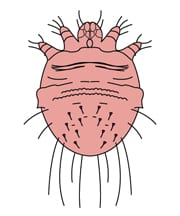Patient Basics: Pubic Lice Or Crab Lice
Originally published by Harvard Health.
What Is It?
Pubic lice or crab lice are tiny insects that infest a person’s pubic hair, although they also can be found on facial hair, armpit hair and eyelashes. The insects look like crabs, and a person with these lice often is said to have “crabs.” Their claws let them grasp hairs so they can both move around and remain on their human host. Crab lice, like all lice, feed only on their host’s blood. Female lice produce eggs, which are cemented to the hair shaft close to the skin. It takes about 7 to 10 days for an egg to hatch. Most people who are infested with crab lice will have about a dozen or fewer active lice on them at any one time, and the hairs may bear many live and hatched eggs.
Symptoms
Crab lice usually cause intense itching, due mainly to an allergic reaction to the saliva of the louse. There also may be tiny red or blue marks where the insect has been biting, and the eggs, or nits, may be seen attached to the pubic hair close to the skin. Sometimes, more severe reactions occur, such as the development of pustules or intense skin reactions where the insects have been feeding. Scratching the area may cause skin infection. Crab lice, themselves, do not transmit infections.
Diagnosis
Diagnosing a crab lice infestation depends on finding the insects and their eggs on the hair. Because most crab louse infestations are transmitted through sexual activity, anyone who has crab lice also should be screened for other sexually transmitted diseases. Several studies have found that many people infested with crab lice also will have another sexually transmitted disease. The sexual partners of someone diagnosed with crab lice infestation should be notified and advised to be checked by a doctor.
Although most crab lice infestations are transmitted through sexual contact, it is possible to get infested with the insects by sharing a bed or clothing with an infested person, and occasionally simply by other direct contacts. Crab lice can live for about 24 hours off of a human host.
Expected Duration
Crab lice infestations usually continue until they are treated. With treatment, the infestation is usually eliminated immediately.
Prevention
To avoid getting crab lice, avoid sexual partners who are infested, and avoiding sharing a bed or clothing with an infested person.
Treatment
Crab lice infestations usually are treated by applying a creme rinse containing 1% permethrin to the pubic hair and leaving it in place for 10 minutes. Also effective are rinses containing 1% lindane or pyrethrins with piperonyl butoxide. Women who are pregnant or lactating should not use lindane. Nits can be removed using a fine-toothed comb after treatment. Clothing and bedding that the infested person used in the two to three days before treatment should be washed in hot water and dried in a clothes dryer on a high heat setting. If crab lice are found on the eyelashes, a doctor should be consulted to prevent injury to the eyes by the treatments.
When To Call A Professional
Although products to treat crab lice infestations are available over the counter, it is a good idea to consult your health care professional if you suspect you may be infested because you also may have another sexually transmitted disease. You also should consult someone if your symptoms are especially severe, and should follow up with your health care professional to be sure the infestation has been treated successfully.
Prognosis
Crab lice infestations respond well to treatment and are not associated with any lasting symptoms.
Additional Info
Centers for Disease Control and Prevention (CDC)
1600 Clifton Rd., NE
Atlanta, GA 30333
Phone: (404) 639-3534
Toll-Free: (800) 311-3435
http://www.cdc.gov/





